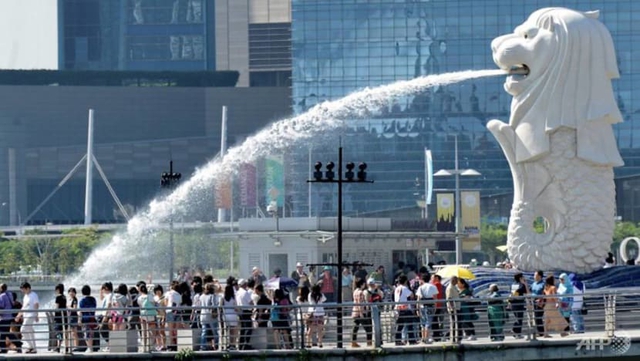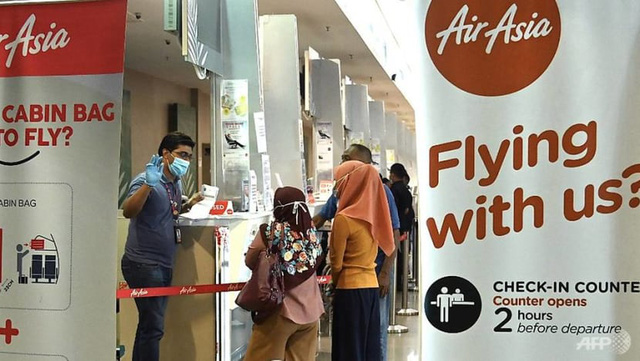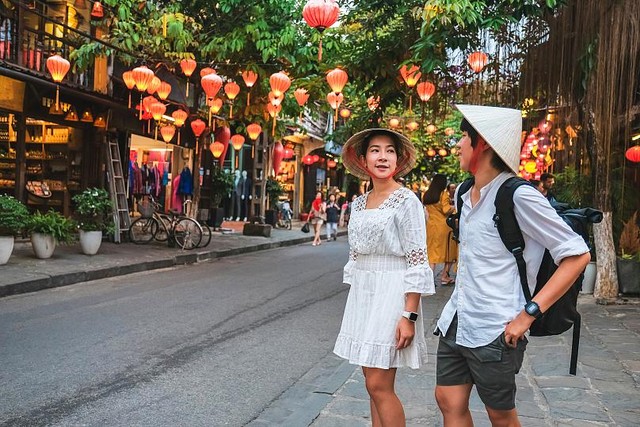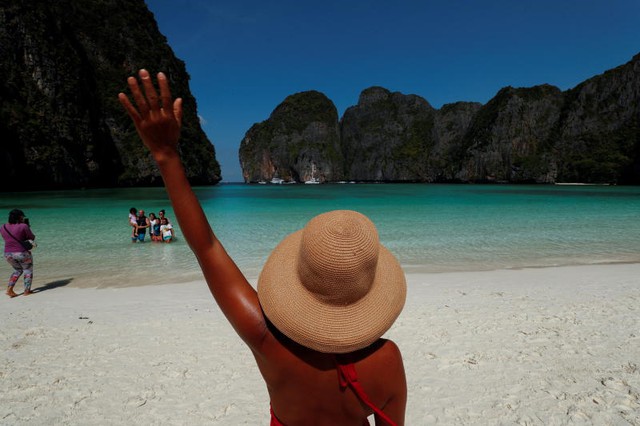ASEAN should promote intra-regional tourism in the post-COVID-19 era
Quang Duy (According to Channel News Asia, Reuters, AFP, AP)–Thursday, March 31, 2022 14:48 GMT+7
ASEAN should promote intra-regional tourism in the post-COVID-19 era – Photo: Getty
Raini Hamdi couldn’t believe it tourism could be so easy. She traveled from Switzerland to Singapore, via Bangkok, without needing a COVID test or using tracing apps. All this travel writer prepares is a certificate of having had enough vaccinations.
People like Raini are not a minority, but part of a wave of tourists in Southeast Asia eager to move as soon as borders are reopened. Every seat in the Singapore Airlines lounge in Terminal 3 of Changi Airport is full, waiting to board the plane after many months. Traveling now feels convenient, just like it was before COVID-19 – the event that completely changed the world and the lives we were used to.

Famous tourist destination of Singapore before the COVID-19 pandemic – Photo: AFP
ASEAN people are ready to withdraw their wallets for tourism
Channel News Asia recently posted positive economic numbers in the ASEAN region. In 2019, the Gross Domestic Product (GDP) of the ten ASEAN countries amounted to 3.2 trillion USD. The ASEAN region’s economy is the world’s fifth largest after the US, China, Japan and Germany. The ASEAN economy is predicted to rise to fourth place by 2030.
According to the same prediction, by that time, 65% of the region’s population will be in the middle class, and 60% of this class will be under the age of 35. ASEAN therefore has a young and energetic population. suitable for many different types of tourism such as travel combining work, study, volunteering or personal travel.

Tourists take pictures on the Chao Praya River in Bangkok on February 19, 2022 – Photo: AP
This is a very important group of consumers of tourism services, but this prospect has not been fully realized in part because Southeast Asia is known as a region that provides attractive tourism services instead of “exporting goods”. “Tourists go to different parts of the world.
However, the actual numbers show that the ASEAN market has a very strong spending power on tourism. In 2019, the group of six ASEAN countries including Indonesia, Malaysia, Thailand, the Philippines, Singapore and Vietnam (temporarily referred to as ASEAN-6) spent a total of about $90 billion on international tourism. This is about a third of what China spends, the world’s number one international tourism exporter, and contributes about 20% of total global international tourism revenue. In the ASEAN-6 group, Singapore spent the most ($25.24 billion), followed by Thailand ($16.85 billion). Spending by the Philippines, Malaysia and Indonesia ranges from 12 to 14 billion USD.
The pandemic has severely affected international tourism in the region. From $90 billion in 2019, ASEAN tourists only spent $24.83 billion in the first year of the pandemic. However, signs of recovery in this sector are quite clear, when spending in 2021 reached 38.55 billion USD. Obviously, this could not be a more appropriate time for countries in the region to promote tourism activities.
Southeast Asia opens slowly and surely
In January, data from online travel service provider Skyscanner showed that travel demand to Southeast Asia skyrocketed as countries such as Thailand, Vietnam, the Philippines, Singapore and Indonesia gradually eased measures. limited when passing the “hurricane” of Omicron.
“High vaccine coverage gives tourists peace of mind when traveling,” Raini said. “Before Omicron appeared, there were countries that loosened isolation regulations, but in general there was a fear of moving. Now, many countries have recorded a record number of cases. Too many community cases make very few people. are afraid of the risks from international tourists.”

The first international tourists to Bali, Indonesia after 2 years of closure against the epidemic – Photo: Reuters
The Indonesian island of Bali welcomed its first international flight back in two years in early February. By the middle of the month, the Philippines welcomed the first 200 guests arriving in Manila after two years. Slowly but surely, ASEAN is reopening to the world.
The number of pre-booked air tickets from the UK, US and Germany to ASEAN countries has increased by 300%. Speaking to Reuters, Skyscanner’s regional director for Asia-Pacific, Paul Whiteway, said: “As restrictions are gradually eased, travelers will find ways to adapt to the new situation to be able to again. go to different countries.”
ASEAN should promote intra-regional tourism
For the tourism industry to return to its pre-pandemic excitement is not an overnight thing when the epidemic situation and each country’s anti-epidemic policy are different. For example, China, the country with the world’s top number of international tourists, still pursues the goal of “zero-COVID” and strictly restricts non-essential travel of people.

Passengers talk to an employee wearing a mask and protective gloves during check-in at Penang International Airport in Malaysia – Photo: AFP
In that context, many experts in ASEAN called for Southeast Asian countries to find ways to promote and attract more tourists in the region. This is a way to take advantage of the convenience of travel distances, procedures as well as a prospect that the tourism industry of all countries will benefit, when regional tourism is forecasted to only return to the trajectory as expected. before the pandemic by 2024. Singapore, Thailand, Malaysia and Cambodia realized this potential and entered into negotiations on a special vaccine visa that would allow travelers to move freely between these countries after arrival. foot in one of four countries.

Tourists visit Hoi An ancient town, Vietnam before the COVID-19 pandemic – Photo: Getty
To be able to attract potential customers within ASEAN, Channel News Asia believes that it is necessary to understand the diversity of customs and cultures of this region. Many people see ASEAN as an independent market. But from the perspective of a tourist destination, this is the most culturally diverse area in the world, suitable for the lifestyle and style of every guest. Not only stopping at picturesque beaches or bustling nightclubs, this area is also diverse in customs and religions.
According to a study by the European Transport Commission, Singapore – a small island nation in terms of area but with global connectivity – had a large number of citizens moving to Australia in 2017. In the same year, Indonesia – a country with largest population in ASEAN – with a large number of citizens going to Saudi Arabia. Indonesia has the largest Muslim population in the world, making it a very important market for Saudi Arabia’s religious tourism industry. A recent survey conducted by ISEAS-Yusof Ishak Institute, Singapore shows that Japan is the most attractive destination for ASEAN tourists. Tourists choosing the land of the rising sun mainly come from Laos, Singapore, Thailand, Philippines, Indonesia and Malaysia. Behind Japan are the European Union and ASEAN countries.
Countries in Southeast Asia can completely increase their attraction to intra-regional tourists through understanding the needs and preferences of people in the region. Among ASEAN countries, Singapore is the most ideal destination, more attractive than Thailand and Indonesia in the next positions.

Tourists arrive at Maya Bay on January 3, 12022 as Thailand reopens its famous beach after being closed for more than three years to restore the ecosystem – Photo: Reuters
In parallel with activities to attract international tourists, ASEAN countries should also pay attention to promoting domestic tourism. More than half of the survey respondents in Thailand showed that they preferred domestic tourism activities. This can be explained by the restrictive measures that still create inconveniences when traveling, and the psychology of stimulating domestic tourism to increase domestic income in the context that the economy has not completely recovered. after the shocks from the epidemic.

Message to welcome back tourists at Sydney airport, Australia – Photo: Reuters
However, for “moving” believers like Raini Hamdi, at the present time, the key is not in bringing the numbers back to the way they were before the epidemic, but the tourism industry needs to attract customers back by dedication and hospitality.
“Australia welcomes its first international guests to Sydney in two years with the lines ‘Welcome to the world!’ painted boldly right next to the runway. Traveling brings joy and great feeling again.”
* Invite readers to watch the programs broadcast by Vietnam Television on TV Online and VTVGo!
at Blogtuan.info – Source: vtv.vn – Read the original article here



